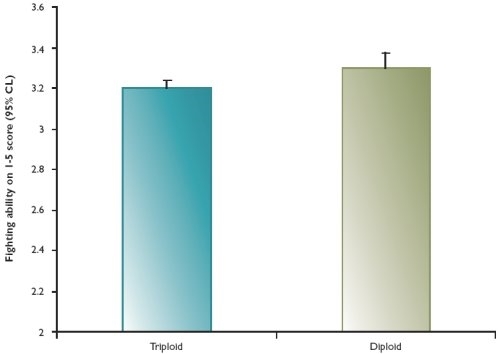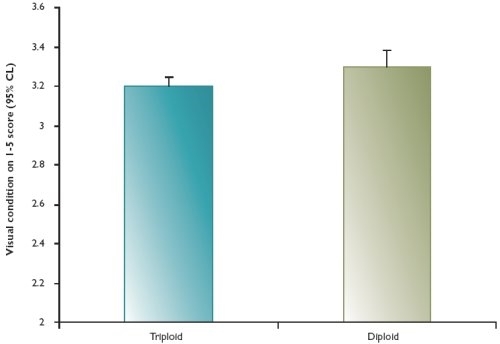Key findings
- Farmed diploid (fertile) and triploid (infertile) trout are equally likely to take dry flies.
- The fighting ability of farmed diploid and triploid trout is similar in anglers’ experience.
- The visual condition of farmed diploid and triploid trout is similar in anglers’ experience.
We started to investigate the performance of stocked triploid (infertile) brown trout compared with normal diploid (fertile) ones and any effects they may have on wild brown trout. The study was commissioned by the Environment Agency (EA) which is our partner in the project and our findings will help to guide the EA’s National Trout and Grayling Fisheries Strategy.
Work began in March 2005 and ran until May 2006, and consisted of three individual studies. The first study adopted many of the sites and techniques used in our diploid stocking project and aimed to investigate the effects of stocking with diploid and in particular triploid fish on the abundance and growth rates of wild fish. We also compared the relative diets of wild and farmed diploid brown trout and farmed triploid brown trout using a non-lethal technique called ‘stomach flushing’.
The second study involved radio-tracking to monitor fish movement and behaviour. This began in September 2005 on two rivers, the River Allen in Dorset (a chalkstream) and the River Arrow, near Kington in Herefordshire (a rain-fed river). We released into each river 60 radio-tagged brown trout consisting of 20 local wild fish, 20 farmed diploid fish and 20 farmed triploid fish in the autumn and monitored behaviour and interactions of the fish over the winter spawning season using fixed ‘listening stations’ and hand held mobile tracking equipment.
Figure 1: Relative fighting ability of farmed triploid and diploid brown trout

Among the anglers surveyed there was very little perceived difference between triploid and diploid trout in terms of fighting ability or visual condition.
The third study was a survey of angler log books, for which we asked anglers at a fishery in the Salisbury area to fill in angler return forms. The fishery had been stocked over a number of visits with a mixture of farmed diploid and farmed triploid brown trout, each about 400g in weight and separately marked. There were spaces on the return form for the anglers to grade the visual condition and fighting ability of any fish caught, using a scoring system ranging from 1-5 where 1 = poor, 2 = below average, 3 = average, 4 = above average, 5 = excellent. There was also space on the form to include the number of hours fished. This study allowed us to investigate whether catch returns of diploid and triploid farmed fish are different and whether the angling experience differs depending on the type of farmed trout.
The initial results from the angler survey show that out of the 52 farmed brown trout that were caught and identified as being experimental fish, 31 were triploid and 21 were diploid. Anglers caught 25 fish of which 12 were triploid and 13 diploid during a ‘dry-fly only’ period, which suggested that both types are equally likely to be caught by this method. In terms of fighting ability (see Figure 1) and visual condition (see Figure 2), triploid and diploid trout scored equally with average scores of just over three (ie. just above average on the 1-5 score).
Figure 2: Relative visual condition of farmed triploid and diploid brown trout
